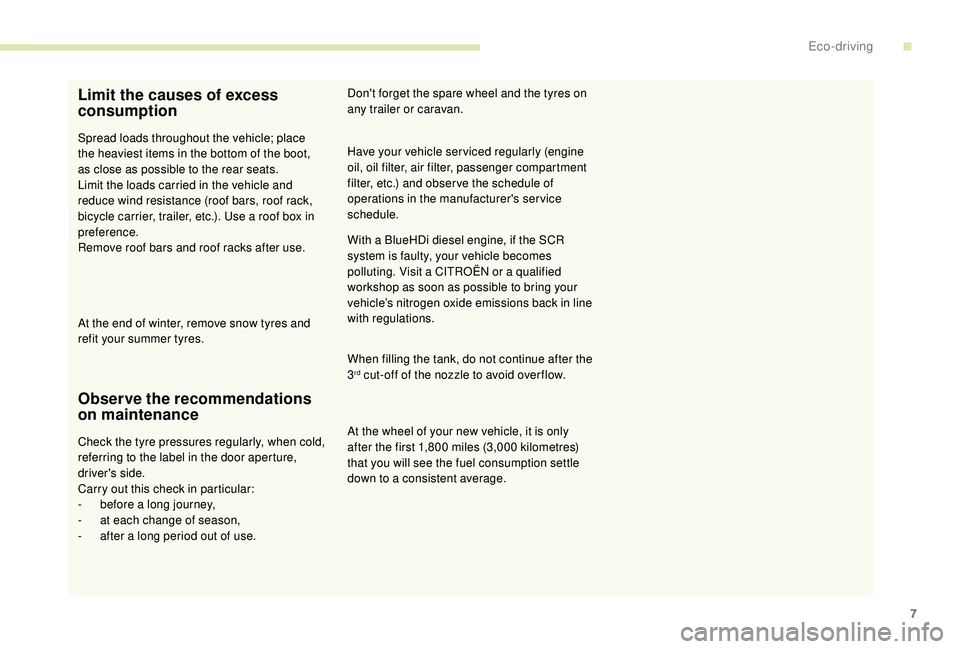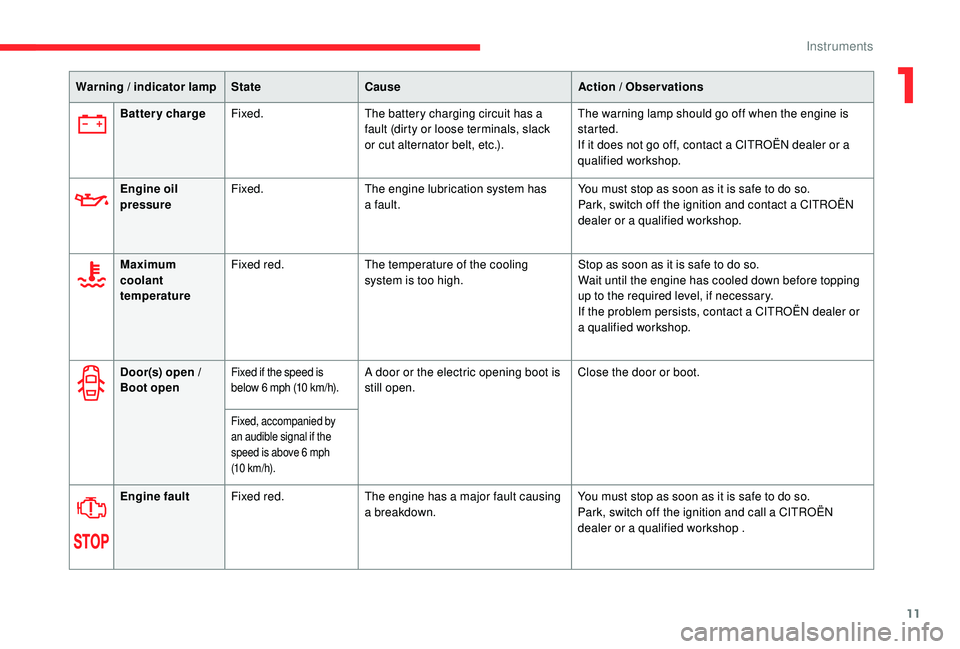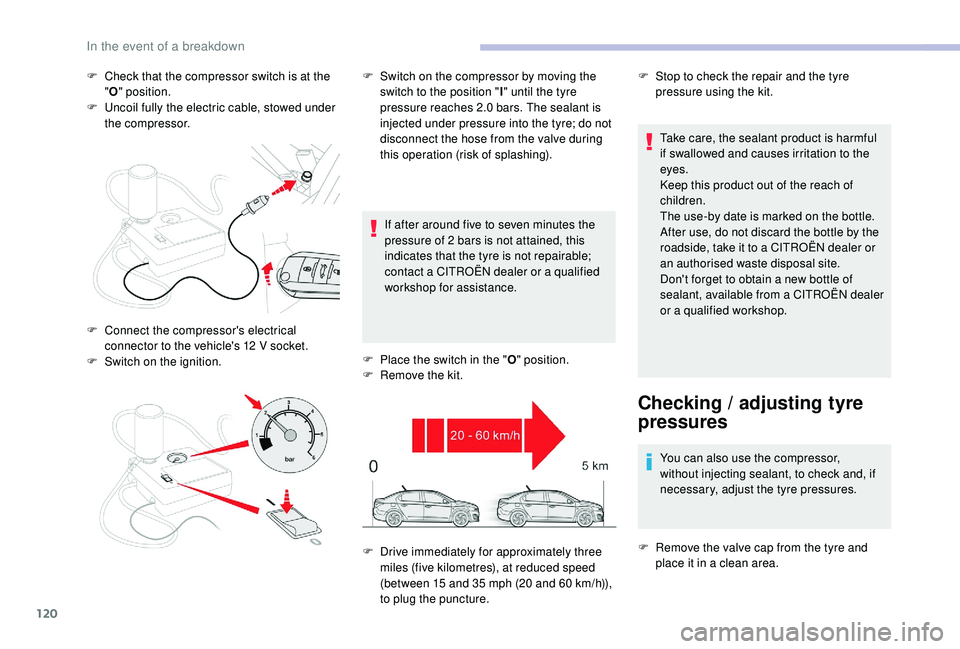low oil pressure CITROEN C-ELYSÉE 2022 Handbook (in English)
[x] Cancel search | Manufacturer: CITROEN, Model Year: 2022, Model line: C-ELYSÉE, Model: CITROEN C-ELYSÉE 2022Pages: 260, PDF Size: 8.4 MB
Page 9 of 260

7
Limit the causes of excess
consumption
Spread loads throughout the vehicle; place
the heaviest items in the bottom of the boot,
as close as possible to the rear seats.
Limit the loads carried in the vehicle and
reduce wind resistance (roof bars, roof rack,
bicycle carrier, trailer, etc.). Use a roof box in
preference.
Remove roof bars and roof racks after use.
At the end of winter, remove snow tyres and
refit your summer tyres.
Observe the recommendations
on maintenance
Check the tyre pressures regularly, when cold,
referring to the label in the door aperture,
driver's side.
Carry out this check in particular:
-
b
efore a long journey,
-
a
t each change of season,
-
a
fter a long period out of use. Have your vehicle ser viced regularly (engine
oil, oil filter, air filter, passenger compartment
filter, etc.) and obser ve the schedule of
operations in the manufacturer's service
schedule. Don't forget the spare wheel and the tyres on
any trailer or caravan.
With a BlueHDi diesel engine, if the SCR
system is faulty, your vehicle becomes
polluting. Visit a CITROËN or a qualified
workshop as soon as possible to bring your
vehicle’s nitrogen oxide emissions back in line
with regulations.
When filling the tank, do not continue after the
3
rd cut-off of the nozzle to avoid over flow.
At the wheel of your new vehicle, it is only
after the first 1,800
miles (3,000 kilometres)
that you will see the fuel consumption settle
down to a consistent average.
.
Eco-driving
Page 13 of 260

11
Door(s) open /
Boot openFixed if the speed is
below 6 mph (10 km/h).A door or the electric opening boot is
still open. Close the door or boot.
Fixed, accompanied by
an audible signal if the
speed is above 6
mph
(10
km/h).
Engine fault Fixed red. The engine has a major fault causing
a breakdown. You must stop as soon as it is safe to do so.
Park, switch off the ignition and call a CITROËN
dealer or a qualified workshop .
Battery charge
Fixed. The battery charging circuit has a
fault (dirty or loose terminals, slack
or cut alternator belt, etc.). The warning lamp should go off when the engine is
started.
If it does not go off, contact a CITROËN dealer or a
qualified workshop.
Engine oil
pressure Fixed.
The engine lubrication system has
a fault. You must stop as soon as it is safe to do so.
Park, switch off the ignition and contact a CITROËN
dealer or a qualified workshop.
Maximum
coolant
temperature Fixed red.
The temperature of the cooling
system is too high. Stop as soon as it is safe to do so.
Wait until the engine has cooled down before topping
up to the required level, if necessary.
If the problem persists, contact a CITROËN dealer or
a qualified workshop.
Warning / indicator lamp
StateCause Action / Observations
1
Instruments
Page 115 of 260

113
Engines
Petrol
Diesel
These engines are examples provided as a
guide.
The locations of the following elements may
vary:
-
E
ngine oil dipstick.
-
E
ngine oil filler cap.
-
P
riming pump. 6.
A i r f i l t e r.
7. Engine oil dipstick.
8. Engine oil filler cap.
9. Priming pump*
To avoid damaging the electrical units,
never use a high-pressure jet wash in the
engine compartment.
The diesel circuit is under very high
pressure.
All work on this circuit must be carried out
only by a CITROËN dealer or a qualified
workshop.
*
D
epending on engine.
1.
Screenwash fluid reservoir.
2. Engine coolant reservoir.
3. Brake fluid reser voir.
4. Battery.
5. Fusebox.
Checking levels
Check all of these levels regularly, in line with
the manufacturer's service schedule. Top them
up if necessary, unless other wise indicated.
If a level drops significantly, have the
corresponding system checked by a CITROËN
dealer or a qualified workshop.
The fluids must comply with the
manufacturer's recommendations and with
the vehicle's engine.
Take care when working under the bonnet,
as certain areas of the engine may be
extremely hot (risk of burns) and the
cooling fan could start at any time (even
with the ignition off).
Used products
Avoid prolonged contact of used oil or
fluids with the skin.
Most of these fluids are harmful to health
or indeed very corrosive.
7
Practical information
Page 121 of 260

119
The vehicle's electrical system allows the
connection of the compressor for long
enough to inflate a tyre after a puncture
repair.
Composition of the kit
1.12 V compressor, with built-in pressure
gauge.
2. Bottle of sealant, with built-in hose.
3. Speed limit sticker.
The speed limit sticker must be secured
to the interior of the vehicle in the driver's
field of vision, to remind you that a wheel
is in temporary use. Do not exceed a speed of 50
mph
(80 km/h) when driving with a tyre repaired
using this type of kit.
Repair procedure
F Switch off the ignition.
F S ecure the speed limit sticker inside the
vehicle.
F
U
ncoil the pipe stowed under the
compressor.
Avoid removing any foreign bodies which
have penetrated into the tyre.
F
C
onnect the pipe from the compressor to
the bottle of sealant. F
R
emove the valve cap from the tyre to be
repaired, and place it in a clean area.
F
T
urn the sealant bottle over and secure it in
the cut-out provided on the compressor.
F
C
onnect the hose from the bottle of sealant
to the valve of the tyre to be repaired and
tighten firmly.
8
In the event of a breakdown
Page 122 of 260

120
F Check that the compressor switch is at the "O " position.
F
U
ncoil fully the electric cable, stowed under
the compressor.
If after around five to seven minutes the
pressure of 2
bars is not attained, this
indicates that the tyre is not repairable;
contact a CITROËN dealer or a qualified
workshop for assistance.
F
P
lace the switch in the "O" position.
F
R
emove the kit.Take care, the sealant product is harmful
if swallowed and causes irritation to the
eyes.
Keep this product out of the reach of
children.
The use-by date is marked on the bottle.
After use, do not discard the bottle by the
roadside, take it to a CITROËN dealer or
an authorised waste disposal site.
Don't forget to obtain a new bottle of
sealant, available from a CITROËN dealer
or a qualified workshop.
Checking / adjusting tyre
pressures
You can also use the compressor,
without injecting sealant, to check and, if
necessary, adjust the tyre pressures.
F
R
emove the valve cap from the tyre and
place it in a clean area.
F
C
onnect the compressor's electrical
connector to the vehicle's 12
V socket.
F
S
witch on the ignition. F
S
witch on the compressor by moving the
switch to the position " I" until the tyre
pressure reaches 2.0
bars. The sealant is
injected under pressure into the tyre; do not
disconnect the hose from the valve during
this operation (risk of splashing). F
S
top to check the repair and the tyre
pressure using the kit.
F
D
rive immediately for approximately three
miles (five kilometres), at reduced speed
(between 15
and 35
mph (20
and 60
km/h)),
to plug the puncture.
In the event of a breakdown